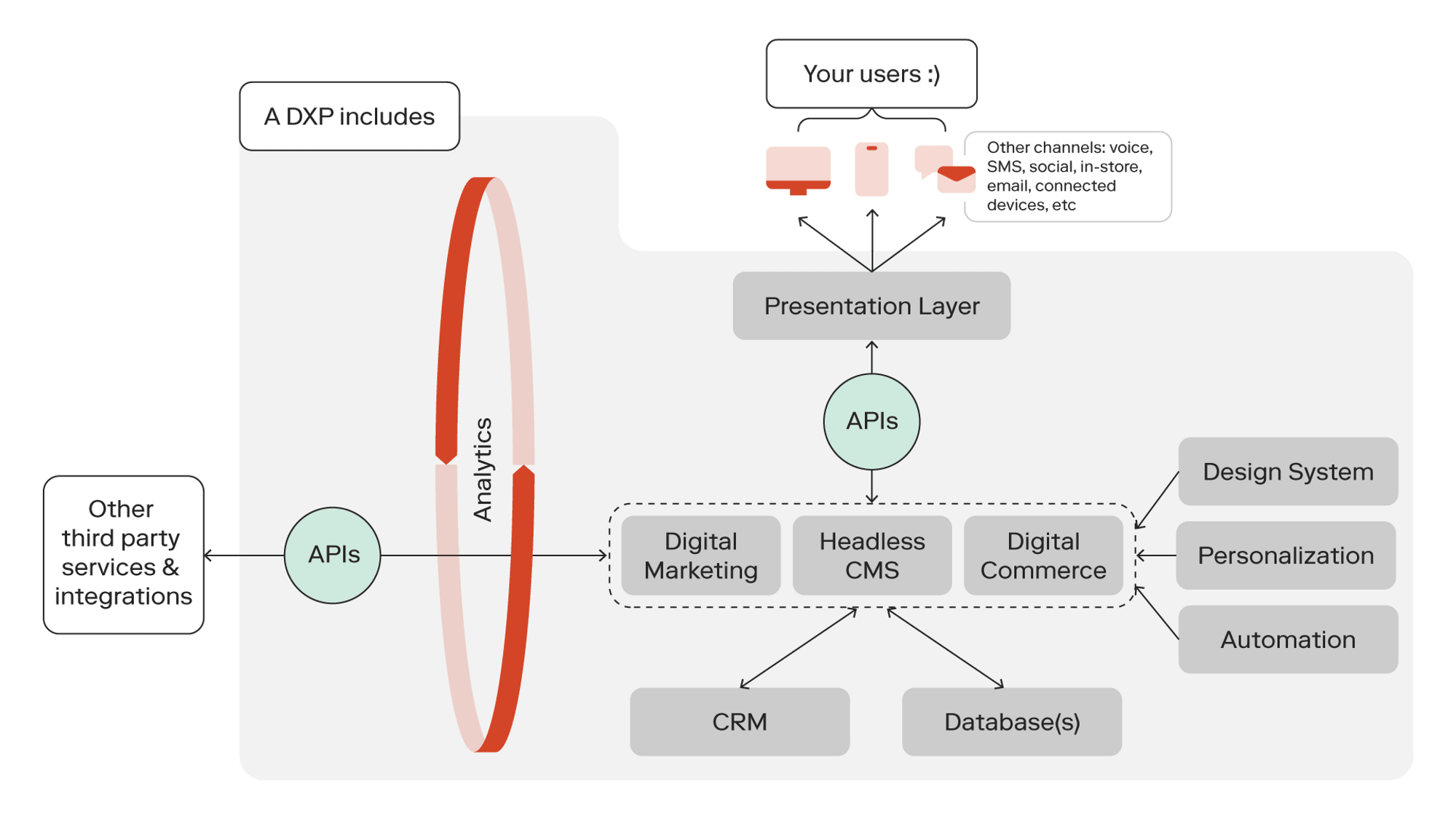If you work in digital, there’s a good chance you’ve heard the term “digital experience platform” over the past year or so. This is an emergent space with new buzzwords, jargon, and ways of working associated with it.
If you’re not really sure where to start or want to deepen your understanding, this overview is for you!
First of all, what is a digital experience platform?
A digital experience platform (”DXP” or “DEP” for short) is an aggregation of software that enables businesses to create, manage, and deliver digital experiences to their customers. A DXP can be used for websites, mobile apps, and other digital properties and can be integrated with many other systems and platforms.
A DXP will often include the following:
- A content management system (CMS)
- Personalization tooling
- Analytics and reporting tools
- API support (to connect to other proprietary or third-party systems)
What type of businesses use, or would benefit from using, a digital experience platform?
A wide range of organizations can benefit from a DXP – it’s especially useful for companies who want to improve their customers’ online experiences and their efficiency in building and operating them. Often, DXPs contribute to industry-leading experiences – Netflix, Peloton, and Spotify all leverage them. As an example, a couple of industries that can benefit a lot from the personalization that DXPs enable are:
Retail
Retail companies can benefit from adopting a DXP to handle all the backend work needed to deliver personalized digital experiences for customers. With the surge in global e-commerce, retailers can easily set up their digital storefronts, accept payments, and track orders across all platforms and sales channels.
DXPs enable retailers to track customer behavioural data to build a customized and personalized experience for every customer and, ultimately, cultivate long-term customer relationships. With real-time insights into customer behaviour, retailers can then make proactive recommendations to optimize the online shopping experience.
Banking
The COVID-19 pandemic drastically reshaped how banks interact with customers and vice versa. Customers’ expectations changed, and banks were forced to shift how they delivered products and services. Today's banks must move away from legacy monolithic systems, invest more in marketing, and build new, or better, customer touchpoints across their digital channels.
A DXP can positively impact a bank’s bottom line by providing consistent and relevant messaging to consumers. This helps drive revenue, loyalty and trust while decreasing costs. With a DXP, banks can engage with customers at the right time with the right services, such as loans, deposits, and issuing cards. Banks can also provide resources customers need, like, or want (e.g. new rewards, alerts to download mobile banking apps, financial education videos, etc.) to drive customer acquisition and retention.
A glossary of common digital experience platform terms
API: A way for one piece of software to send and request information from another piece of software. Most modern digital tools have an API so systems can be connected more easily.
Composable: A modular way to build digital experiences that offers flexibility and agility, and allows to launch better customer experiences more quickly.
Composable Architecture: A modular approach to putting together several different pieces of software in a way that allows you to choose the best tools for the job.
Composable Content: Content designed to be organized, combined, and shaped in different ways to drive innovative experiences across numerous devices and channels.
Content Model: A template that outlines what information is needed, what format it should be in, and how it should be organized. A content model for a news article might include text fields for the headline, author, date, and main body and image fields if there are any visuals in the article.
Design Systems: A set of interconnected design principles, guidelines, and assets that help teams create consistent, high-quality digital experiences.
Digital Experience: All digital interactions across channels that consumers have with your brand throughout the customer journey.
Digital Experience Composition (DXC): A method of creating digital experiences (like websites and mobile apps) that combine modular, reusable components. One of our partners, Stackbit, is at the forefront of this emerging category of tooling.
Headless CMS: A backend platform that manages digital content detached from the frontend (visual layer) of a website.
Jamstack: This term stands for JavaScript, APIs, and Markup and indicates a way to build web applications. The frontend of the website or web application is built using JavaScript, and APIs are used to interact with the backend services.
MACH: This term stands for: microservices, API-first, cloud-native, and headless. This modern architecture model is used for building modern digital experiences.
Microservice Architecture: A large application separated into smaller, independent services that communicate with each other through APIs. Each microservice is responsible for a specific task and can be deployed, managed, and scaled independently. This results in a more flexible, scalable, and manageable system, as changes to one microservice do not affect the others.
Monolithic Architecture: All of the different features and functions of these systems are tightly integrated and cannot be easily separated or replaced. This makes them inflexible, hard to scale, deploy, and test and maintain.
Site Builder: A tool that allows users to create and manage a website without needing to have technical skills or knowledge of web development. It provides an intuitive user interface, making it easy to create and publish a website by dragging and dropping elements, such as text, images, and videos, into pre-designed templates.
Structured Content: Content that is broken down into its smallest reasonable pieces, which are set up to be understandable by both computers and humans.
So how does this all fit together?

Interested in learning more?
Check out these other articles we've written about Digital Experience Platforms or reach out and say hi to Adrienne 👋🏻





